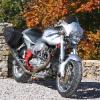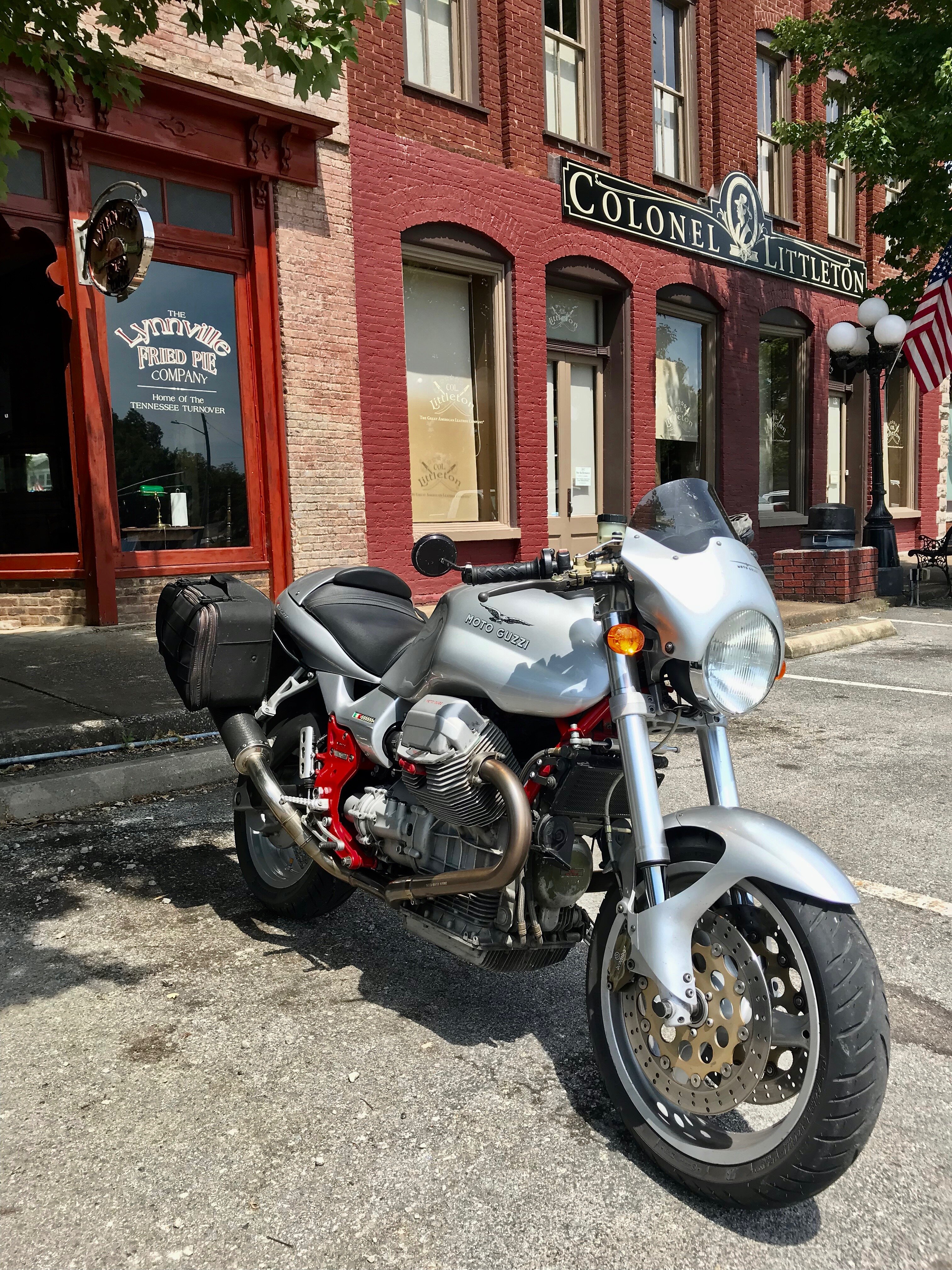-
Posts
19,923 -
Joined
-
Last visited
-
Days Won
1,132
Content Type
Profiles
Forums
Events
Gallery
Community Map
Everything posted by docc
-
So . . . that's why those cats won't wave!
-
My weasel feels better aligned now. But, it aches a little. In a good way, though. . . (Look, really, I used a laser to align my swingarm after the *dumb-ass* crash. And it rides better. Everything you do to these bikes to tune and fine-tune helps. Except the stuff that makes it worse and tosses you into an oncoming 3-series sedan. My bad. I won't do that set-up again.)
-
I believe this thread is too valuable to have it closed. Ya'll play nicely.
-
Dad-gum! Rat thar nere the X-on. S'pose the wild girl from Year One at the Super8 in Athens has made bail by now? Looks like her kind of place. . . At least we have Wayne covered. I'm goin' to the Huddle House to suck my thumb and order grits . . .
-
Questions have come up about restaurants and such walking distance from the Comfort Inn. The folks at the hotel tell me they serve a continental breakfast with 'make your own waffle." Across the street (25W/411) is Lois's Country Kitchen, the Huddle House, Timeout Deli and the Exxon makes burgers, sanwiches and sells beer. Both Audrey's Bar and Grill and the Midnight Rodeo serve food. About four miles east on I40 is another exit with a Cracker Barrel and much, much more. PLEASE NOTE: THE BRIDGE OVER DOUGLAS LAKE WILL BE CLOSED! INTERSTATE 40 WILL BE CLOSED WEST OF THE 411/25W EXIT (EXIT 432) 8 MILES TO EXIT 424. Detours are posted and it should be no big deal. Just a heads up if you're coming in from the west on I40. Bill and I have tweaked the route for Saturday looping north into VA/KY 238 miles. I'll try to print up some maps and directions. If you have Garmin MapSource, pm me and I'll send you the file. Later, docc
-
We did pick a weekend with lots of other rallyes going on, but not by design. (Not that we even have a design). In the past our route took us to lunch in Franklin where we could sit quietly next to some of the people we passed en masse to get there. No brawling, though (North Carolinians are a gentle people). This year we're headed north through the corners of Virginia and Kentucky where we'll have to be much more careful where we sit down for lunch. Sorry we'll miss seeing your Cafe Sport! Perhaps next year it is a fair turn-about for the husband to bring his VFR (very nice bikes!). Ride well, docc
-
Good news! It's certainly worth switching to upgraded relays if you have not done so already (OMRON, GEI, or Bosch) Lot's of old threads with links and such.
-
I could lick a Stelvio. Don't let me around the Grappa . . they don't allow this sort of thing in East Tennessee . . . (Otherwise): I'm hearing the grumblings of folks prepping their Guzzis for a gathering. If *you* are wondering if *you* should show up (*you* know who *you* are!), this is it! *I* can't wait!!
-
Aww! You've ratted us out! But, I've heard there is a really knarly downhill gravel back way in . . .
-
I'll see if I can get a bead on the oil temp sensor. That's the one I bedded in the brass housing, no?
-
Time to dust off the V11, mount that new tire and charge the battery. Two weeks from Friday and it's off to the mountains!
-
Once again, Spine Raiders of the Lost Art will rendezvous in a few weeks just east of Knoxville, Tennessee, to hobnob, cohort and otherwise test brake rotor temperatures. By the time the proper 'technical fluids' are applied to the results, the final tally could be beyond the interpretation margins of internet posting. In other words, you should come in person and and cast your very own jaundiced eye on the proceedings. Bring your own technical fluids. Meetings and Clubs Forum
-
Why didn't I think of that?
-
Just drove through these mountains with the family in the Volvo T5 Bomber. Nice area, even by interstate. There is no excuse for even the most garage bound V11 Stalwart not to come show their stuff at the Spine Raid. OK, I guess if you live in Belgium . . . Even then, I have a guest room . . .
-
And . . . so, then . . . how is it poured ? ?
-
I wouldn't think the fuel inside would blister the paint outside. Yet, I have heard of others having paint issues with their tank. Perhaps they'll chime in?? What color is the paint?
-
Oh, I'd grind a nut of for you guys, sure I would . . .
-
Left over parts are simply placed in the universe to make you drink more ale. In fact, I think I'll have one too . . .
-
Don't know much about Californias, but the "air gap" is more important than the volume . . .
-

Redneck back on a Guzzi
docc replied to todd haven's topic in Special place for banter and conversation
Funny how both TX/RN/Jim and CA/?/Dave came to my rescue when I needed help with my wrecked Sport. Kindness, apparently, knows no boundaries. -
And why isn't there (or is there?) St. Andrew's Day for the Scots? "St. Andy's Day" . . . has a nice ring . I'll have another pint. And with some proper Scottish slogan, like: "Touch Not the Cat, Lest I Do Something Ugly to Yer Bike's Wiring Harness." (or however that comes out in Gaidhlig).
-
Sniff . . . it makes me justly proud. I think I'll have a pint. As if my folks weren't stern and dour enough they married in with Germans. My dad, a military bomb disposal expert, didn't joke around much, but if he did, it was wise to laugh. He apparently disliked motorbikes, reportedly having dumped a Harley rather indelicately pulling up to the Officer's Club. Yes: the 17th! (The 18th was my late mother's birthday). Erin Go Bragh : Ireland Forever
-
So, next week, the 18th of March, we call "Saint Patrick's Day" here in the States. Lots of us have Irish roots. Probably after being 'transported' here by the Crown for various and dubious acts. I'm thinking me Great-Grandmother Nolan is me Irish tie. Which and whatever, the Guiness will not be be left by on the designated day. Trouble is: what is this "Erin Go Bragh" business? Ireland duz sumpin' I'm guessin', but what??
-

Ahh, the great escape
docc replied to belfastguzzi's topic in Special place for banter and conversation
What a gas! I just brought this movie home two days ago to watch with my 15 year old. He was completely captivated ny the whole sense of suspense and daring! I suppose I saw the thing once on NBC Saturday Night at the Movies around 1968. Oh, how we 'remember' things! I "remember" him jumping four or five fences and getting away! Hmmm, not so! Also, I thought McQueen did his own jumps. The riding, yes, but the jump was done by his riding buddy: Bud Ekins. -
Weird is as weird does But, there is hope: after 8 inches of snow here Saturday (odd for Tennessee), it's like sunny and 72F for next Saturday. The known antidote for Winter Weirdness!

